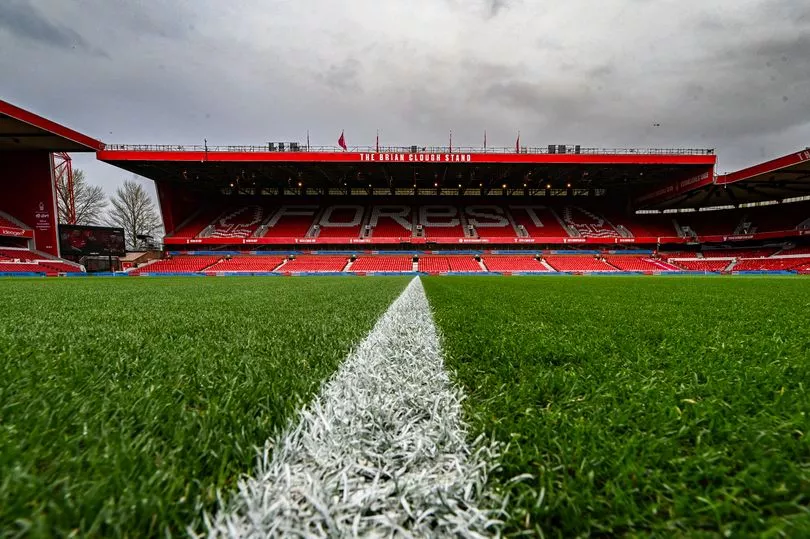Latest Nottingham Forest news as research is conducted on the feasibility of safe standing at the City Ground.
Nottingham Forest have acknowledged that they have investigated the idea of establishing safe standing zones at the City Ground.
In 2021, it was reported that Premier League and Championship clubs would be able to offer licensed standing zones in stadiums as part of a test experiment beginning January 1, 2022. Manchester City, Manchester United, Chelsea, Liverpool, and Luton Town all have such areas on their grounds.
The Reds’ chairman, Tom Cartledge, has previously described the club’s attitude as “pro-safe standing.” And now, specifics of Forest’s investigation into the possibility of executing the notion have been shared.
Craig North, the Reds’ head of procurement and estates, presented on “the work the club have carried out over the past six months” during last month’s Fan Advisory Board (FAB) meeting. Safe standing is considered as a means to “alleviate the pressure” from the Sports venue Safety Authority (SGSA) and the Safety Advisory Group (SAG) on prolonged standing at the venue, while also “improving fan experience”.

According to the club’s meeting minutes, “He (North) guided the FAB through the club’s research, speaking with various suppliers and clubs.” Nottingham Forest has toured multiple Premier League stadiums, both independently and with suppliers, to evaluate the various rail seating alternatives available to the club. While there are other systems available, the two most common are integrated rail/seat systems and separate rails fitted around the existing system.
“Craig added that Safe Standing would ideally be introduced to the City Ground in various phases with the first phase looking to implement 2,364 seats in home areas in both the Bridgford Upper and Lower tiers, and 1,262 seats in the away area of the Bridgford Lower as per Premier League rules.”
Forza Garibaldi, a supporters’ club, has long championed the notion. They had a representative at the FAB meeting, Harry Fish, who conducted a discussion of Forza’s prior research.
According to their meeting notes, “We are encouraging Forest to install the legitimate rail seating, which includes an entire new frame and flush seating, and we presented a short piece within the meeting highlighting the importance of this solution being the chosen type at the City Ground.” The case of Everton was also mentioned, since they are future-proofing their new stadium by integrating rail seating, which might increase the capacity of the new stand from 13,000 to 20,000 provided certain conditions are met and regulation allows. Given capacity constraints at the City Ground, this is clearly a better option than inserting rails into existing seats, which will just take up more room.
“We welcomed the opportunity to distribute our previous presentation to the FAB, and we also noted Luton’s recent progress, which increased attendance by 800 by installing a bespoke rail seated solution.” We think Forest can use this dynamic strategy to maximise capacity while simultaneously improving the supporter experience.
“Ultimately, Forest appear to be in the research stage and will need to (as with all club decisions) find the best cost-benefit solution.” We would oppose funding safe standing through additional pricing in certain locations, and we do not believe the club would be willing to do so nonetheless. However, the bottom line is that this would be a large financial commitment for the club with no immediate monetary return, therefore we would welcome more discussion on how to justify the expenditure in order to identify the best solution.”
The topic about safe standing comes as Forest faces criticism for persistently standing on the ground. In February, the club issued a statement warning of “severe sanctions” if the matter was not resolved.
Their report of the FAB meeting, which took place in the City Ground boardroom, stated: “The City Ground is licensed for seated spectators. Persistent standing at all seater stadiums poses a substantial safety risk due to the possibility of successive crowd collapses. The SGSA inspects all stadiums and reports any safety concerns. They have placed the club as one of the top five in the country for the highest risk of a serious safety event due to its long standing.
“The SGSA and SAG have the ability to decrease the club’s capacity if there is persistent standing in a location licensed only for seated. Craig (North) explained how the club is concerned about the gravity of the potential of injury to supporters while also recognising the need of protecting our famous atmosphere. The ramifications of a capacity reduction, as well as the impact on the atmosphere, are a major issue for the club, as is the constraint on matchday revenue.”
